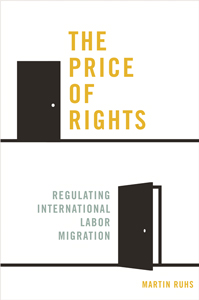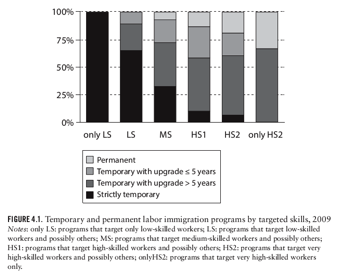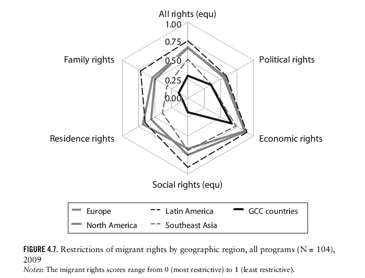By: Martin Ruhs, University Lecturer in Political Economy and Senior Researcher
 How do high-income countries regulate labour immigration? I have analysed policies in over 46 countries and this blog summarises some of the key findings. For a more detailed discussion, see my recent book The Price of Rights: Regulating International Labour Migration.
How do high-income countries regulate labour immigration? I have analysed policies in over 46 countries and this blog summarises some of the key findings. For a more detailed discussion, see my recent book The Price of Rights: Regulating International Labour Migration.
Measuring labour immigration policy: Openness, skills and rights
At its core, the design of a labour immigration policy requires policy decisions on three fundamental issues: how to regulate openness i.e. the number of migrants to be admitted (e.g., through quotas); how to select migrants (e.g., by skill); and what rights to grant migrants after admission (e.g., temporary or permanent residence; access to welfare benefits; and limited or unlimited rights to employment).
Most countries operate different labour immigration policies for admitting migrants for employment in low-, medium- and high-skilled jobs. Policies for different skill groups of workers are typically associated with different degrees of policy openness and rights for migrants. This is why I use labour immigration programmes rather than countries as a whole as my unit of analysis.
For my empirical analysis, I constructed two separate indexes that measure: (i) the openness of 104 labour immigration programmes in 46 high- and middle-income countries to admitting migrant workers; and (ii) the legal rights (civil and political, economic, social, residency, and family reunion rights) granted to migrant workers admitted under these programmes. The Appendix at the end of this blog includes the lists of indicators I used for measuring openness and rights.
To explore the potential variation of openness and rights across labour immigration programmes that aim to admit migrants with different skills, each of the programmes included in my analysis was assigned one or more ‘targeted skill level’. The targeted skill level of a labour immigration programme reflects the skills required in the (specific or range of) jobs that migrants are admitted to fill.
The results below refer to the year 2009.
The Appendix includes more explanation of the methods used in my analysis.
Ten key features of labour immigration policies in high-income countries
The following features refer to the 104 labour immigration programmes analysed in my study.
1. Temporary migration programmes predominate. The great majority of labour immigration programmes in high- and middle-income countries (just under 90 percent in my study) are temporary migration programmes (TMPs) i.e., programmes that grant temporary residence status on arrival (although some of them allow a transfer to permanent residence status after some time).
2. Permanent migration programmes (PMPs) limited to higher-skilled programmes. The existing permanent immigration programmes (i.e., programmes that grant permanent residence on arrival) target higher-skilled workers. Nevertheless, even among programmes that target very high skilled workers only, two-thirds are associated with temporary rather than permanent residence status on arrival.
3. “Demand side restrictions” most common. Quotas and “demand-side” restrictions on labour immigration (i.e., requirements of employers in receiving countries) are much more common than supply- side restrictions (i.e., restrictions related to the characteristics of migrants such as age). Supply-side restrictions are most common among points-based systems for permanent immigration.
4. Modes of immigration control related to labour markets and welfare states. There are different “modes of immigration control”—different ways of restricting labour immigration—that vary across welfare states and varieties of capitalism (i.e., liberal, coordinated, and mixed market economies). For example, programmes in liberal economies and welfare states make less use of demand restrictions than programmes in coordinated economies.
5. Greater openness to skilled labour immigration. Openness to labour immigration is positively related to the skill level targeted by the labour immigration programme—that is, programmes that target high-skilled migrant workers place fewer restrictions on admission than those targeting lower-skilled migrants. Important and interesting exceptions include the US, Sweden and the Gulf States.
6. Variations in rights restrictions. There is considerable variation in the legal rights granted to migrant workers under different labour immigration programmes, both within and across countries. Among the types of rights I analysed, the six most commonly restricted rights are the rights to stand for elections and vote (two political rights), the spouse’s right to work, direct access to citizenship, and the time limit on and security of residence (four residence and family rights). The two most commonly restricted social rights relate to access to unemployment benefits and social housing. The right to free choice of employment was the only economic right that was found to be commonly restricted in this analysis of legal rights.
7. TMPs restrict many more rights than PMPs. Temporary labour immigration programmes impose significantly greater restrictions on the rights of migrant workers than permanent migration programmes.
8. Migrant rights vary across regions, Gulf countries most restrictive. The legal rights that migrant workers enjoy under labour immigration programmes also vary across different regions of the world (see the figure below). Labour immigration programmes in GCC countries and Southeast Asia place significantly more restrictions on migrant rights than programmes in Latin America, Europe, and North America.
9. More rights for migrants under skilled labour immigration programmes. There is a positive relationship between some of the rights granted to migrant workers and the skill level targeted by the immigration programme—that is, programmes that target higher-skilled migrants impose fewer restrictions on some rights than programmes targeting lower- skilled migrants. This holds for many but not all rights. Political rights are less sensitive to targeted skills than other types of rights.
10. Trade-offs between openness and some rights. Among programmes in upper high-income countries in the sample, there are trade-offs (i.e., negative relationships) between some specific rights (e.g., selected social rights) and openness to labour immigration. More open admission policies are associated with greater restrictions of migrant rights, and vice versa. The trade-offs can be found in policies for admitting migrant workers with a range of skills but not in programmes specifically designed to target the most highly skilled migrants only.
Appendix: Definitions and methods
For a much more detailed discussion of methods and results of my analysis, see chapter 4 of my book The Price of Rights.
Labour immigration programmes: The analysis focuses on labour immigration programmes, defined as policies for regulating the number, skills, and rights of migrants who are admitted for the primary purpose of work. For EU countries, I focus on policies for admitting non-EEA workers only.
Migrant Rights: In my analysis, the term ‘migrant rights’ refers to the legal rights (defined here as the rights granted by national laws and policies) granted to migrant workers on admission under a particular labour immigration programme.
Programmes and countries: The analysis includes 104 labour immigration programmes in 46 high- and middle-income countries. I have included all high-income countries (as defined by the World Bank) with a population of more than 2 million and, to ensure broad geographic coverage, a selection of middle-income countries.
Policy Openness Indicators: I have defined openness as “policy openness” measured by the scale and strength of policy restrictions on the admission and employment of migrant workers. My policy openness index includes three types of restrictions: (i) quotas; (ii) criteria that employers in the host country need to meet to legally employ migrant workers (“demand restrictions”); and (iii) criteria that potential migrant workers need to meet to be admitted to the host country (“supply restrictions”). The openness index comprises a total of twelve indicators: existence, types and strength of quota; demand restrictions including the requirement of job offer; strength of labour market tests; restrictions of wages and conditions; occupational/sectoral restrictions; economic fees for employing migrants; and the degree of trade union involvement; supply restrictions including nationality and age restrictions; gender and marital status restrictions; specific skills requirements; language requirement; and self-sufficiency requirements.
Migrant Rights Indicators: My indicators of migrant rights include a mix of different types of rights including: five civil and political rights (vote, stand for election, associate, keep identity documents, protection of criminal courts); five economic rights (free choice of employment, equal pay, equal conditions other than pay, join trade unions, redress in case of contract violation); five social rights (access to unemployment benefits, public pension schemes, public education and training, social housing, public health services); five “residency rights” (time limit on residence, security of residence dependent on employment and criminal convictions, direct access to citizenship, redress in case of withdrawal of residence permit); and three rights related to family reunion (family reunion, spouse’s right to work, redress).
I focus on rights that are granted upon admission under the labour immigration programmes that I have analysed. Importantly, my indicators measure rights in laws and regulations rather than in practice.
FURTHER READING:
For an excellent review of the small but rapidly growing body of research on measuring immigration and citizenship policies, see http://www.marc-helbling.ch/wp-content/uploads/test/migcit-newsletter-vol1-2_summer-2013.pdf
Ruhs, M (2013) The Price of Rights: Regulating International Labour Migration, Princeton University Press [website and blog: www.priceofrights.com]

